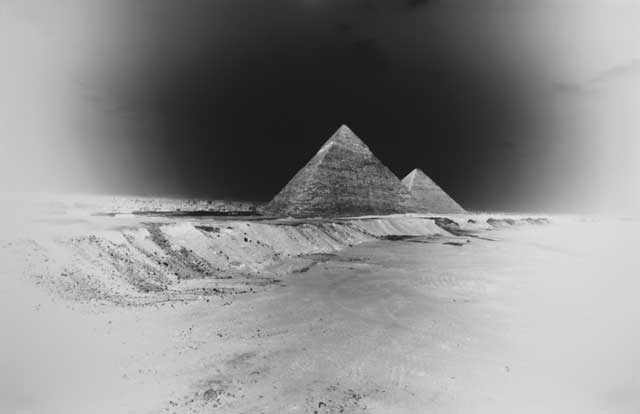Egypt seen from inside Vera Lutter's suitcase

Your support helps us to tell the story
From reproductive rights to climate change to Big Tech, The Independent is on the ground when the story is developing. Whether it's investigating the financials of Elon Musk's pro-Trump PAC or producing our latest documentary, 'The A Word', which shines a light on the American women fighting for reproductive rights, we know how important it is to parse out the facts from the messaging.
At such a critical moment in US history, we need reporters on the ground. Your donation allows us to keep sending journalists to speak to both sides of the story.
The Independent is trusted by Americans across the entire political spectrum. And unlike many other quality news outlets, we choose not to lock Americans out of our reporting and analysis with paywalls. We believe quality journalism should be available to everyone, paid for by those who can afford it.
Your support makes all the difference.First the photographer Vera Lutter turned her suitcase into a pinhole camera, lining it with photosensitive paper. Then she lugged it around Egypt, in the scorching heat, to capture ghostly photographs of ancient architecture. Her new Egypt series of pictures, including pyramids and temples, is now on show at London's Gagosian Gallery.
Transforming her going away bag into a covert camera obscura was practical as well as primitive.
"I packed all my clothes, suntan lotion, developing trays, and photographic paper. The suitcase doubled as my luggage and a camera. Then of course I had to empty it all to create an optical device," explains Lutter. "It's basically an old 'trunk' style suitcase with a hole to let the light in that is opened and closed by hand to control the exposure. I got some very strange looks from tourists as I placed my suitcase on the sand in front of the pyramids. The sun is very strong and it took about a minute for an exposure. Then I dashed back to the hotel to develop it into a print, before I could reload the suitcase for the next exposure."
She first began experimenting with her signature technique in 1993 in New York. She turned a whole room of the flat that she was squatting in into a large pinhole camera. Exposing directly onto wall-size sheets of photographic paper, she created large-scale black and white images of her immediate urban surroundings.
She continued working internationally using the technique of pinhole camera, to capture architecture, shipyards, airports, and abandoned factories.
It was only last year that she decided to pack her bags and head off to Egypt. Her one-off photographs include the Red and Bent pyramids in Dahshur and the Chephren and Cheops pyramids in Giza, which in her photographs look as if it they are built on a crater of the moon. She also managed to gain access into the Kom Ombo temple, where she captured tourists as apparitions, against the imposing architectural backdrop.
"I was smitten with the quality of the images taken from my suitcase. I got that uneven exposure, which lends itself perfectly to the subject matter that I was photographing. Using my suitcase as a pinhole camera, it made a familiar image like the pyramids look foreign. This invites a dialogue with the viewer and between the mysterious and magnificent desert landscape and those ancient structures."
Vera Lutter, Gagosian Gallery, London W1 (www.gagosian.com) to 21 May
Join our commenting forum
Join thought-provoking conversations, follow other Independent readers and see their replies
Comments